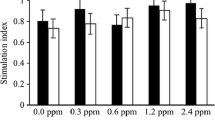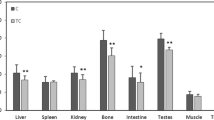Abstract.
Arsenic is a ubiquitous contaminant of many toxic waste sites around the country and experimental animal trials have indicated that arsenic may be immunotoxic to laboratory rodents. Because wild rodents such as the herbivorous cotton rat (Sigmodon hispidus) reside on many of these toxic waste sites, we explored the sensitivity of their immune systems to oral exposures of environmentally relevant concentrations of inorganic arsenic. We exposed adult male cotton rats (n = 36) to either 0 (controls), 5 (low dose), or 10 (high dose) ppm sodium arsenite in drinking water for 6 weeks. Daily food intake decreased in a dose-dependent manner, ranging from an average of 10.03 ± 0.45 in the high-dose group to 11.27 ± 0.42 (SE) g/animal/day in the control group. Mass of testes in the low-dose group increased significantly compared to controls, but there was no difference between the high-dose and control groups. Masses of liver, kidney, adrenals, popliteal lymph nodes, spleen, epididymides, and seminal vesicles and selected hematological parameters were unaffected by arsenic exposure. In vivo cell-mediated immunity, as measured by a phytohemagglutinin-hypersensitivity response to an intradermal challenge, was suppressed 30% in the low-dose group compared to controls; however, responses of those receiving a high dose of arsenic were similar to controls. Arsenic treatment did not have a measurable impact on lymphoproliferative responses of cultured splenocytes to the mitogens Concanavalin A and Pokeweed mitogen, or to the lymphokine interleukin-2. We also observed no impact of low-level arsenic exposure on macrophage phagocytic activity and tumoricidal activity of lymphokine-activated killer cells in vitro. It is possible that malnutrition caused by decreased food intake may eventually lead to atrophy of lymphoid organs and render animals more susceptible to environmental pathogens. However, direct effects of low-level arsenic exposure on immune function of cotton rats was minimal (a moderate depression in the in vivo cell-mediated immunity assay) and may not be clinically relevant with regard to susceptibility to disease in the wild.
Similar content being viewed by others
Author information
Authors and Affiliations
Additional information
Received: 6 July 1997/Accepted: 17 September 1997
Rights and permissions
About this article
Cite this article
Savabieasfahani, M., Lochmiller, R., Rafferty, D. et al. Sensitivity of Wild Cotton Rats (Sigmodon hispidus) to the Immunotoxic Effects of Low-Level Arsenic Exposure. Arch. Environ. Contam. Toxicol. 34, 289–296 (1998). https://doi.org/10.1007/s002449900320
Issue Date:
DOI: https://doi.org/10.1007/s002449900320




